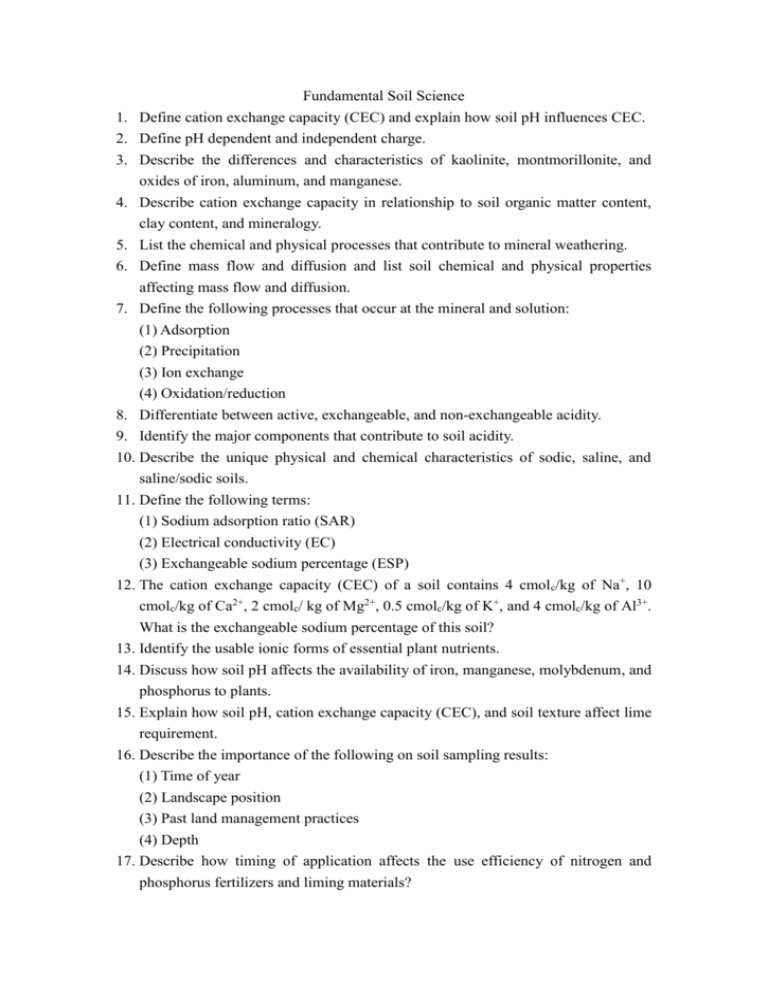Fundamental Soil Science Define cation exchange capacity (CEC
advertisement

Fundamental Soil Science 1. Define cation exchange capacity (CEC) and explain how soil pH influences CEC. 2. Define pH dependent and independent charge. 3. Describe the differences and characteristics of kaolinite, montmorillonite, and oxides of iron, aluminum, and manganese. 4. Describe cation exchange capacity in relationship to soil organic matter content, clay content, and mineralogy. 5. List the chemical and physical processes that contribute to mineral weathering. 6. Define mass flow and diffusion and list soil chemical and physical properties affecting mass flow and diffusion. 7. Define the following processes that occur at the mineral and solution: (1) Adsorption (2) Precipitation (3) Ion exchange (4) Oxidation/reduction 8. Differentiate between active, exchangeable, and non-exchangeable acidity. 9. Identify the major components that contribute to soil acidity. 10. Describe the unique physical and chemical characteristics of sodic, saline, and saline/sodic soils. 11. Define the following terms: (1) Sodium adsorption ratio (SAR) (2) Electrical conductivity (EC) (3) Exchangeable sodium percentage (ESP) 12. The cation exchange capacity (CEC) of a soil contains 4 cmolc/kg of Na+, 10 cmolc/kg of Ca2+, 2 cmolc/ kg of Mg2+, 0.5 cmolc/kg of K+, and 4 cmolc/kg of Al3+. What is the exchangeable sodium percentage of this soil? 13. Identify the usable ionic forms of essential plant nutrients. 14. Discuss how soil pH affects the availability of iron, manganese, molybdenum, and phosphorus to plants. 15. Explain how soil pH, cation exchange capacity (CEC), and soil texture affect lime requirement. 16. Describe the importance of the following on soil sampling results: (1) Time of year (2) Landscape position (3) Past land management practices (4) Depth 17. Describe how timing of application affects the use efficiency of nitrogen and phosphorus fertilizers and liming materials? 18. List the USDA soil particle size classes. 19. A soil core is taken using a core (ring) that has a 2 cm diameter and is 10 cm tall. The core weights 22.5 g and the moisture tin used for drying the core weights 65.2 g. The total wet weight of the soil, core and moisture tin is 136.3 g and the dry weight is 128.6 g. Calculate the soil bulk density and porosity assuming that particle density is 2.65 g/cm3. 20. Describe how soil texture and structure influence water movement and water holding capacity. 21. 26 g of wet soil is placed in a container weighing 2 g. After drying the container plus soil weighs 23 g. Calculate the gravimetric and volumetric water contents assuming that this soil has a bulk density of 1.2 g/cm3? 22. Define field capacity, permanent wilting point, and matric potential. 23. Describe how soil color, soil water content, surface residue, and landscape position affect soil temperature. 24. Explain how soil bulk density, particle density, porosity, and structure influence soil aeration. 25. Describe how soil compaction affects infiltration, permeability, bulk density and thermal conductivity. 26. Describe the five soil forming factors. 27. Explain eluviation, illuviation, and chemical weathering. 28. Define the master horizons of a soil profile. 29. Explain how soil structure, texture, color, and bulk density vary with soil depth. 30. Explain the following diagnostic surface epipedons: (1) Histic (2) Melanic (3) Mollic (4) Umbric 31. Name the major groups of soil microorganisms and group these microorganisms according to how they obtain their carbon and energy. 32. Describe the importance of soil microorganisms to soil processes. 33. Define rhizosphere and plant-growth promoting rhizobacteria. 34. Explain how soil nutrient levels and pH affect the abundance of soil organisms and their relative proportions. 35. Describe beneficial interactions between plant roots and mycorrhizal fungi. 36. Describe the benefits to both rhizobia and the legume in the N2-fixing symbiosis. 37. Describe how the rate of decomposition of organic materials varies based on C:N ratio, lignin content, size of residue, and clay content. 38. Define the following terms related to the nitrogen cycle: (1) Nitrification (2) Denitrification (3) Immobilization (4) Mineralization 39. Explain how organic influences soil aggregate formation and stability matter. 40. Explain why microorganisms are important for organic matter production. 41. Describe how soil management, texture, precipitation, and temperature affect the amount of organic matter present in soil. 42. Define and describe bioremediation and phytoremediation. 43. Describe how microbial activities impact the production of greenhouse gases. 44. Identify soil conditions that contribute to soil erosion by water. 45. Explain the effects of residue management on soil erosion. 46. Define soil quality and describe how organic matter, pH, bulk density, and biological activity affect soil quality. 47. Describe methods to improve plant growth on highly acidic soils. 48. Describe how pH influences the uptake of heavy metals. 49. Describe soil properties influenced by irrigation with poor quality water. 50. Describe water conservation practices used to reduce the frequency of irrigation.




